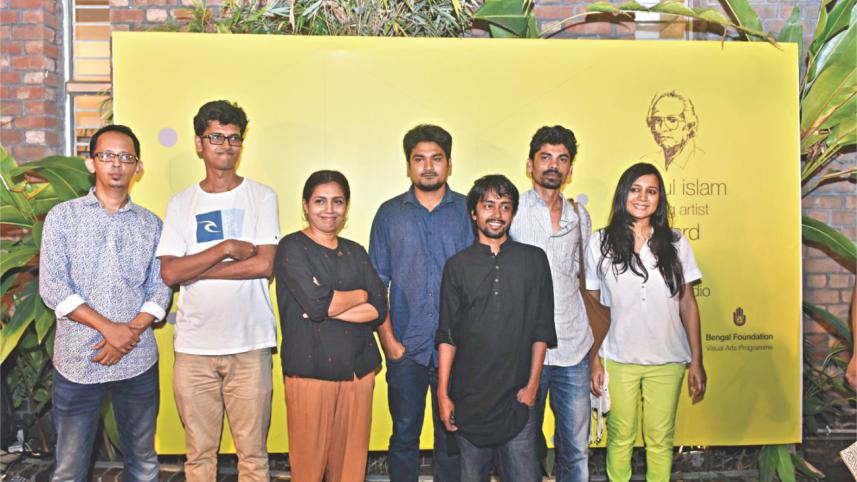A Beautiful Array of Artistic Expression
and Open Studio at Bidyapeeth

To preserve the memory of Artist Aminul Islam, his family introduced the Aminul Islam Young Artist Award in 2013. For their contributions to art, two young artists are selected for the awards on a biennial basis. Artist Aminul Islam (1931-2011) is amongst the first generation artists and a leading member of the pioneering modern art movement in Bangladesh.
There was a nationwide call for young artists to submit their artworks in order to choose the winners of the award by an independent jury. For the 2015 awards, 10 artists were shortlisted. An open studio has been arranged to showcase the selected works by the artists.
This year's winners were announced at the inauguration of the open studio, organised by Bengal Foundation on July 23. The award ceremony, held at Gyantapash Abdur Razzaq Bidyapeeth, Dhanmondi, Dhaka, was attended by eminent artist Mustafa Monwar, artist Dhali Al Mamoon, Ruby Islam (Aminul Islam's wife), and the chairman of Bengal Foundation, Abul Khair.
The 10 shortlisted artists – Ali Asgar, Palash Baran Biswas, Palash Bhattacharjee, Rafiqul Islam Shuvo, Razib Datta, Reetu Sattar, Rupam Roy, Salma Abedin Prithi, Samsul Alam Helal and Zihan Karim -- have dealt with a vast range of mediums like video, performance, photography, printmaking, drawing, sculpture and installation.
The winners of the Aminul Islam Young Artist Award 2015 are Rafiqul Islam Shuvo and Razib Datta.
Rafiqul Islam Shuvo treads on several new avenues of artistic expression, including, sculptural installations, painting, video and photography. His artworks mainly focus on the ontological influence of time, responsible for the evolution of human behaviour in a geographical periphery. Unexpected pauses, sudden cuts, long silences, juxtaposed editing, and a tendency of repetition create a certain cinematic style in Shuvo's videos.
Incorporating drawing, text and digital art, Razib Datta deconstructs the traditional language of art and cinema in his works. With an attempt of creating “non-sense”, Razib often collects photographs, newspapers and film stills to conceptualise his work. In his series of small drawings, an absurdist character named Ramiz travels around the city with an eye to understanding contemporary events.

Ali Asgar explores the issues of gender identity, masculinity, and the socio-cultural concerns that relate to gender practices of men in a hetero-normative society. Exploring different contemporary media for years, Ali took performance as his forte. He does not view art as a catalyst for the transformation of society; rather, he sees art as a reflection of a society.
Palas Baran Biswas's lithographs are the reflections of the human condition inside and outside of socio-political structures. He explores the complexities of social values. His work often responds to contemporary issues and traces the struggle of social relationships.
Palash Bhattacharjee's praxis traverses an array of experimental art ranging from performance, installation, to video. He loves to carry out aesthetic experimentations derived from his personal experiences.
Using theatre, performance, video, text and object, Reetu Sattar's works navigate through memory, loss and resilience. Since 2010, she has been exploring performance as her artistic expression. Reetu's background in theatre led her to engage in performance art and elucidate personal emotions.
Rupam Roy's enigmatic sculptures are the experimentations of the relationship between sound and object. He analyses sources of sounds and draws lines in spontaneous gestures, in response to a sound piece – with the preference of losing control in the process.
Salma Abedin Prithi's works are monologues of ordinary people about their relationships in front of the camera. The texts and letters on prints become an integral part of her photographs. Prithi is particularly interested in rituals and women's iconography. Her recent works focus on women in domestic roles, where she confronted her own upbringing and questioned her fears and desires.
Samsul Alam Helal tells stories of various people. Exploring their identities, dreams and longings through his photography, Helal often creates dramatic moods through vibrant colours. As opposed to mere fiction, his work represents reality in an alternate space.
Audio-visual artist Zihan Karim explores the subtleties of time, space, and societal issues through the syntax of video, installation, sound and painting. His work intends to create a new dialogue between the virtual and reality.
The exhibition ends today.




 For all latest news, follow The Daily Star's Google News channel.
For all latest news, follow The Daily Star's Google News channel.
Comments